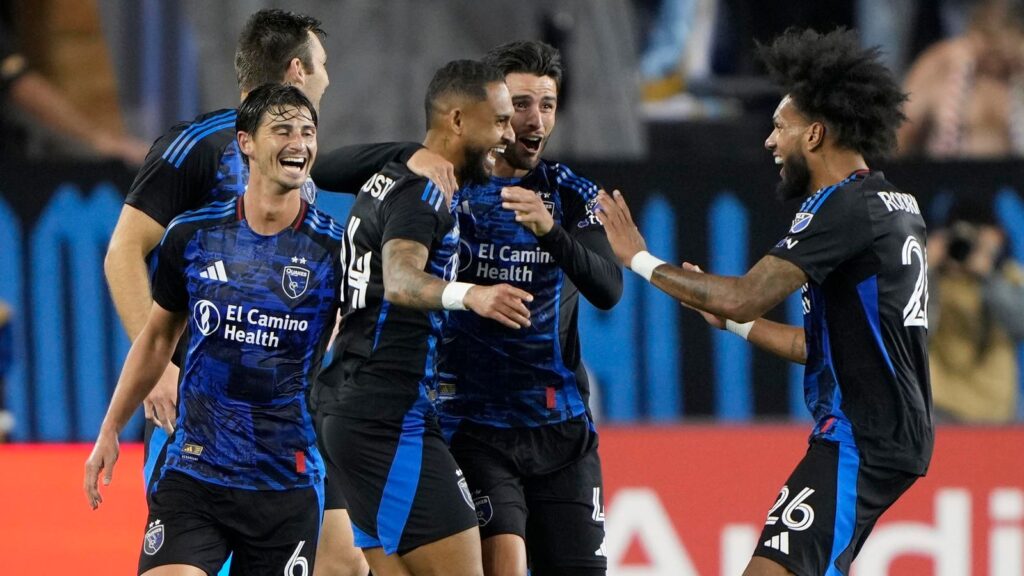Members of the San Jose Earthquakes celebrate after their 4-0 win over Real Salt Lake on Saturday … [+]
Among Major League Soccer’s opening weekend matches was one fitting this description: The league’s all-time winningest manager made his debut at his fifth club, fielding a lineup that includes two former MLS Cup-winning strikers, one of them playing against his former team.
Yet Bruce Arena’s San Jose Earthquakes are barely on the radar as the league’s 30th season begins, despite their history as one of the league’s founding members, a two-time MLS Cup champion and the first club of legendary MLS player Landon Donovan. And while a resounding 4-0 win over Real Salt Lake will make some waves with hardcore MLS followers, the Quakes for the moment are the fourth-most discussed MLS club in their own state now that expansion darlings San Diego FC are here.
Even in the sleeping giant frustration rankings, the Quakes lag. On paper, there should be just as much frustration in league circles at San Jose’s limited profile in the nation’s fifth-largest combined statistical area (or CSA) as there is at the relatively anonymity of the two teams in New York or the one each in Chicago and Houston. In reality, it often feels like there is more resignation to the Quakes’ fate as a relative minnow, perhaps shaped by gratitude that it’s still a better one than what happened to baseball’s Oakland Athletics and football’s now-Las Vegas Raiders.
Yet there’s every reason to believe San Jose could in fact a sleeping giant if Arena’s project leads to a long-term revival on the field, combined with strong decision making in the club marketing department off the pitch.
Here’s what the Quakes have working in their favor:
A Large, Underserved Sports Market
The Bay Area is vast, and it’s not exactly like San Jose, San Francisco and Oakland are immediate neighbors. Even so, census estimates say there are more than 9 million total people in the CSA that includes the three cities.
It’s the largest such CSA in the country that now has only one major professional men’s baseball, football, basketball and hockey team. In terms of major women’s pro sports, the NWSL’s Bay FC shares PayPal Park with the Quakes, but there is no WNBA team in the region. In the era after the A’s and Raiders, there is plenty of local sports media real estate the Quakes could occupy with a more aggressive and/or successful approach.
A Soccer Hotbed
Additionally, the San Francisco Bay Area is one deep soccer roots and culture. A third of for U.S. women’s national team roster for the 2023 FIFA World Cup had some sort of Bay Area ties. On the men’s side, Stanford is one of the modern powers of the collegiate game, and the University of San Francisco was one of the NCAA’s early soccer giants.
Naomi Girma, one of the world’s best defenders is a San Jose native. Former Iran international Steven Beitashour is also from San Jose, and all-time leading MLS goalscorer Chris Wondolowski – a Quakes legend – grew up in nearby Danville, Calif.
A Historic Foundation
The Quakes should also be able to convey a sense of authenticity and deep roots that can turn a club into a community institution, in the way the Seattle Sounders and Portland Timbers have done successfully.
While the colors are different, the Quakes have revived a team name that previously applied to an NASL team that played from the mid-1970s to the late 1980s.
In their MLS era, the Quakes (as the San Jose Clash) hosted the first-ever match in MLS history, decided by that memorable Eric Wynalda winner. In the early days of Landon Donovan’s career – the guy the MLS MVP award is named after – the Quakes won two MLS cups in the space of three seasons.
A ‘New America’ Culture
Commissioner Don Garber has often championed MLS as “a league for new America,” insinuating that the MLS product is one for a younger and more progressive audience. While the meaning of that loaded phrase depends on who is considering it, there are few markets who have more aspects of what Garber is conjuring than the Bay Area.
There’s the region’s tech culture heritage, which includes the Apple company based in nearby Cupertino, Calif. (MLS and Apple TV are in the third year of a 10-year, worldwide streaming partnership.) There’s also the region’s minority-majority demographics, with Hispanics and Asians each making up nearly as large segment of the population as Whites.
Read the full article here
